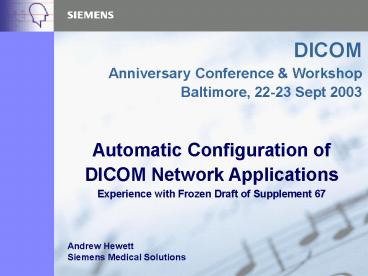Automatic Configuration of DICOM Network Applications PowerPoint PPT Presentation
Title: Automatic Configuration of DICOM Network Applications
1
Automatic Configuration of DICOM Network
Applications
DICOM Anniversary Conference
WorkshopBaltimore, 22-23 Sept 2003
- Experience with Frozen Draft of Supplement 67
Andrew Hewett Siemens Medical Solutions
2
Scope DICOM Configuration Management
(Supplement 67)
Scope Status Quo Future Vision Profiles Trial Test
Cases Experience
- Simplify installation and maintenance of DICOM
Network Applications - Reduce manual data entry of network parameters
- Automate collection of network parameters
- Automate distribution of network parameters
- Use industry standard IT network protocols
- DHCP Obtain Network Parameters
- DNS Resolve names to addresses
- NTP Maintain accurate synchronized time
- LDAP Directory lookup of network devices
capabilities
3
Status Quo Install a new Workstation
Scope Status Quo Future Vision Profiles Trial Test
Cases Experience
- Administrator / Technician / User
- Identify network parameters of new Workstation
- Manual entry of self network parameters
- Hostname, IP-Address, Netmask, DNS, Default
Gateway, - Unused Unique AE Title(s), Local Port, Supported
Services, - Manual entry of remote node network parameters
for each device with which communication is
desired - Hostnames, IP-addresses, AE Titles, Ports
- Supported Services, Roles, Transfer Syntaxes
- Device type (e.g. RIS, Archive, Printer, ),
- Visit each device in network
- Manually enter network parameters of new WS
4
Future Install a new Workstation(Centrally
Driven)
- Administrator
- Creates name/credentials and registers WS with
DHCP/DNS/LDAP - Loads predefined WS configuration in LDAP server
- Device details, hostname, ports, AETs, SOP
Classes, etc. - Peer (Workflow) Devices, etc.
- Technician
- Installs hardware enters WS name/credentials
- Workstation Automatically
- Obtains network parameters synchronizes to
network time - Obtains own configuration from LDAP server
- Technician
- Refines WS configuration (if necessary)
Scope Status Quo Future Vision Profiles Trial Test
Cases Experience
5
Future Install a new Workstation(Client Driven)
- Administrator
- Creates name/credentials and registers WS with
DHCP/DNS/LDAP - Technician
- Installs hardware enters WS name/credentials
- Workstation Automatically
- Obtains network parameters synchronizes to
network time - Identifies available unique DICOM AE Title(s) for
own use - Registers WS own capabilities to LDAP server
- Searches for interesting remote DICOM devices
in LDAP Server - RIS, Archive, Network Printers, Workstations
- Technician
- Refines WS configuration (if necessary)
Scope Status Quo Future Vision Profiles Trial Test
Cases Experience
6
Future Send images to a new WS
Scope Status Quo Future Vision Profiles Trial Test
Cases Experience
- A new WS is installed
- Other devices can immediately send images to new
WS - Fully Dynamic Configuration (e.g. on a Modality)
- Open Patient Browser (view of Local Database)
- Select Patient and choose Send to WS
- Dialog shows filtered list of assigned
Workstations - Obtained from central config server
- Select desired WS (if more than 1)
- Send images to selected WS
- Using network parameters obtained from central
config server (LDAP DNS) - Many variations on this theme are possible
7
Configuration Management Profiles
Scope Status Quo Future Vision Profiles Trial Test
Cases Experience
- Products can claim conformance to separate
Profiles - Network Address Management Profile
- Obtain Network Parameters Resolve names to
addresses - Client must support DHCP DNS
- Time Synchronization Profile
- Maintain accurate synchronized time
- Client must support SNTP or NTP
- DICOM Application Configuration Management
Profile - Directory lookup of network devices
capabilities - Client must support LDAP protocol DICOM schema
- Each Profile defines
- Actors Transactions (Required/Optional)
8
Configuration Management Profiles
Scope Status Quo Future Vision Profiles Trial Test
Cases Experience
- Products can claim conformance to separate
Profiles - Network Address Management Profile
- Obtain Network Parameters Resolve names to
addresses - Client must support DHCP DNS
- Time Synchronization Profile
- Maintain accurate synchronized time
- Client must support SNTP or NTP
- DICOM Application Configuration Management
Profile - Directory lookup of network devices
capabilities - Client must support LDAP protocol DICOM schema
- Each Profile defines
- Actors Transactions (Required/Optional)
9
Trial Implementation
Scope Status Quo Future Vision Profiles Trial Test
Cases Experience
- WG6 created a Frozen Draft for Trial
Implementation - Sup67 is unusual for DICOM Standardization
- Discover and fix problems before Ballot
- Frozen Draft status will be reviewed in January
2004 - Siemens has developed a demo client
implementation - Microsoft .NET Environment
- Uses DirectoryServices class library for LDAP
client support - Tested against the SunONE and OpenLDAP directory
servers
10
Test Cases
Scope Status Quo Future Vision Profiles Trial Test
Cases Experience
- Install a new LDAP Server into a legacy network
- Install a new managed device (pre-loaded LDAP
Server configuration) - Install a new managed device (file-based data
upload) - Install a new managed device (protocol-based data
upload) - Find archives, workstations and printers
- Change managed device configuration on the server
- Change managed device configuration (file-based
data upload) - Change managed device configuration
(protocol-based data upload)
11
Trial Experience
Scope Status Quo Future Vision Profiles Trial Test
Cases Experience
- Successfully completed all LDAP-related test
cases - Limitations of LDAP server products client
libraries - Multi-valued RDNs
- Modify RDN
- Minor revisions to DICOM LDAP schema necessary
- Clarification of some details necessary
- Renaming a device
- Intended use of Peer AE Titles
- Important to test with multiple LDAP servers
- Strict vs. lenient syntax checking

